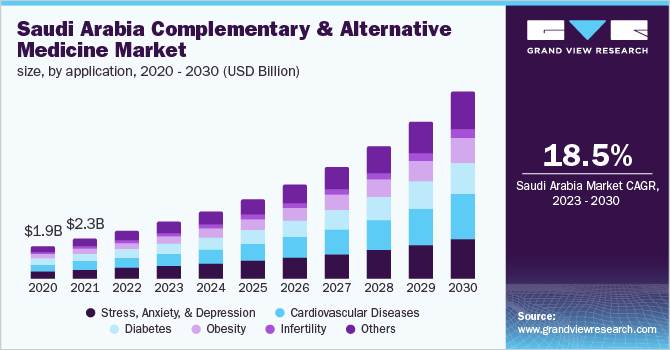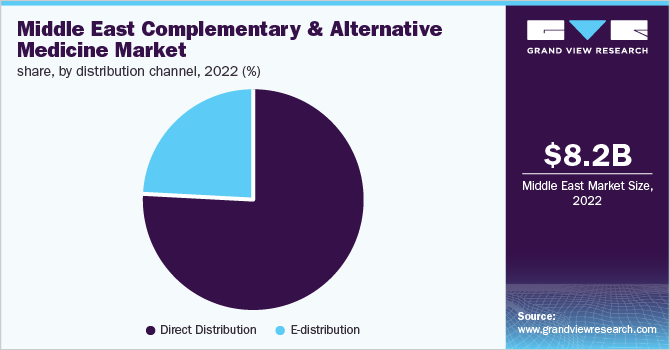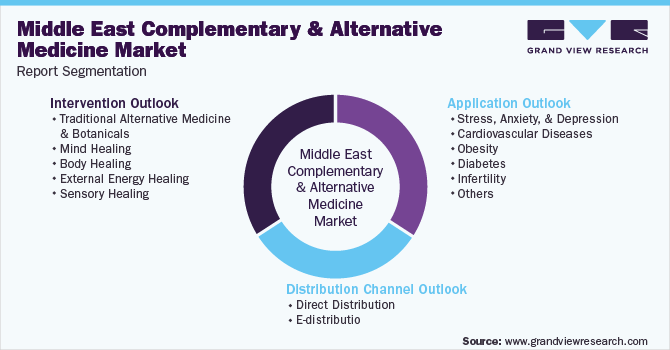- Home
- »
- Pharmaceuticals
- »
-
Middle East Complementary And Alternative Medicine Market Report 2030GVR Report cover
![Middle East Complementary And Alternative Medicine Market Size, Share & Trends Report]()
Middle East Complementary And Alternative Medicine Market Size, Share & Trends Analysis Report By Intervention (Traditional Alternative Medicine & Botanicals), By Application, By Distribution Channel, And Segment Forecasts, 2023 - 2030
- Report ID: GVR-4-68039-322-8
- Number of Pages: 140
- Format: Electronic (PDF)
- Historical Range: 2018 - 2021
- Industry: Healthcare
Report Overview
The Middle East complementary and alternative medicine market size was valued at USD 8,176.4 million in 2022 and is expected to expand at a compound annual growth rate (CAGR) of 20.18% from 2023 to 2030. Complementary and alternative medicine (CAM) is commonly used in the Middle East as it is associated with Islamic history and herbal treatments stated in Quran and is often recognized in the region as “Islamic” or “Arabic” medicine. The Middle East offers lucrative opportunities to the market, in which communities have an extensive history of using numerous spiritual techniques along with the use of herbal medicines for the treatment of various disorders, including diabetes mellitus, pain management, hypertension, mental disorders, asthma, and gynecological disorders.

The outbreak of the COVID-19 pandemic led to an increase in research studies oriented toward the use of traditional medicines for the treatment of the disease. The government authorities in this region are keen on promoting the use of traditional alternatives in COVID-19 treatment, however, it is imperative to cater to the conventional research standards devised for all the other drug candidates. This trend has notably started after several research studies conducted on the ability of diverse medicinal plants to offer effective treatment to COVID-19 patients. In addition, in the recent past, WHO has also acknowledged and stated that complementary and alternative medicines exhibit several benefits, that may assist in the effective, safe, and maximum at-home management of COVID-19 symptoms.
Complementary and alternative medicine in the Middle East region is defined as a non-conventional therapeutic approach opted by patients, particularly interventions such as botanicals/herbal remedies replacing conventional treatments. The utilization of complementary and alternative health services has expanded rapidly in recent years in the Middle East region, and its intervention is expected to penetrate across the treatment of chronic ailments, such as oncology disorders. The concept of botanical treatment or herbal medicine is deeply rooted in traditional Islamic medicine, wherein this complementary alternative medicine intervention plays a pivotal role in the local medical culture. In addition, the use of complementary and alternative medicines is considered to be a safe and noninvasive approach, which has led to increasing utilization of such services by the Middle East population, with many botanical compounds found in the local environment of the Middle Eastern countries.
Thus, an increase in the penetration of complementary and alternative medicine interventions has been observed across several oncology centers in recent years. These services include botanical/herbal medicines and acupuncture, among others; use of dietary & other herbal supplements, particularly, in integrated cancer care; and designing a patient-specific treatment plan incorporating complementary and alternative medicine healthcare services. For instance, in October 2020, a study was conducted on the use of complementary and alternative medicine in Saudi Arabia by Jamal Alhamad and Amal S. Alazmi. Over 74% of participants used CAM to treat multiple medical conditions.
Furthermore, an increase in the geriatric population in the region is expected to boost the market growth in the region. According to the WHO, in 2050, 80% of older people (above 60) will be living in low- and middle-income countries. Commonly, older people are increasingly choosing complementary and alternative medicine treatments, especially acupuncture, herbal products, bloodletting, medical massage, cauterization, and religious rituals. There are several factors associated with complementary and alternative medicine use in the geriatric population, including gender, education level, ethnicity, and availability of health caregivers in the area of residence. In addition, certain disease conditions such as back pain, insomnia, Alzheimer’s disease, and colds are associated with the use of complementary and alternative medicines among older people.
Moreover, the growing adoption of therapies associated with complementary and alternative medicine in several regions of the Middle East is anticipated to fuel the market over the forecast years. The use of complementary and alternative medicine therapies has increased in Iran. For instance, in March 2022, a study published on BioMed Central Ltd. portal stated that herbal products are the most commonly used CAM therapies by patients suffering from pressure ulcers. According to the study, 71.9% of the subjects use complementary and alternative medicine therapies in the region for managing chronic diseases, while the rest of them use them to manage acute diseases.
Intervention Insights
The traditional alternative medicines and botanicals segment dominated the market in 2022 and captured the maximum share of more than 36.28% of the overall revenue. The Middle Eastern region and its cultures offer lucrative opportunities to players in the complementary and alternative medicines market, owing to a history of commonly practiced spiritual healing techniques and herbal medicine, such as Unani, for the treatment of several disorders. As a result, traditional medicine practitioners are a vital part of disease management in the region. Traditional alternative medicines and botanicals include naturopathic medicine, traditional Chinese medicine, and traditional Arabic medicine.
The body healing segment is anticipated to be the fastest-growing intervention segment with a CAGR of 21.93% during the forecast period. Owing to the increasing burden of chronic diseases and the rising popularity of alternative medicines, several new healing centers are being launched in this space in the Middle East. For instance, in July 2021, the Lootah Group of Companies, in partnership with Kerala's Santhigiri Group, launched the Santhigiri Holistic Healthcare Centre in Dubai, which offers a range of alternative medicine varieties such as acupuncture, homeopathy, chiropractic, and yoga. Such centers are likely to boost the market over the forecast period.
Application Insights
The stress, anxiety, and depression segment held the highest share of the market at 23.41% in 2022. Stress, anxiety, and depression are among the commonly prevalent mental health disorders in the Middle East. As the region is home to a large subset of conflict-affected populations, including Palestinians, Yemenis, and Iraqis, poor mental health & lack of professional mental health treatment options are prominent in several Middle Eastern countries. Due to this, an increasing trend toward the adoption of natural, traditional, and complementary remedies for boosting mental health has been witnessed over the past few years. Hence, with the rapid increase in lifestyle-associated changes, growing geopolitical pressures, and the resultant rise in mental health-associated conditions in the region, the segment is expected to significantly grow in the coming years.
The cardiovascular diseases segment is expected to grow at the fastest rate over the next few years. Cardiovascular Diseases (CVD) represent a leading cause of death in the Middle East. As per the World Heart Federation, CVDs are responsible for over 1.4 million, or one-third of all deaths in the Middle East and North Africa, annually. Patients with cardiovascular diseases, such as coronary heart disease, are required to improve their lifestyle and adopt several self-management activities to maximize their quality of life. As a result, several complementary medicine options are widely used for self-treatment, especially due to the high impact of religious beliefs in the Middle East.
Distribution Channel Insights
Direct distribution channels emerged as the dominant segment of the total revenue share in 2022. This is attributed to the high rates of self-prescribed use of complementary and alternative medicine products, particularly botanicals and traditional medicines. Pharmacists and healthcare professionals are recommended to conduct community-based programs aimed at spreading awareness about botanicals, which can boost the usage of complementary and alternative medicine services accessed directly by physicians. Moreover, in Saudi Arabia, herbal medicines/botanicals are available at reasonable costs across both herbal remedy shops, including unregistered products and pharmacies with registered products. This promotes the implementation of herbal medicines in the societies of Saudi Arabia.

The E-distribution segment is projected to expand at the fastest CAGR from 2023 to 2030 due to the increasing demand for complementary and alternative medicine through online channels. In addition, increased adoption of the internet and online methods, such as video training, to communicate & train the patient can help boost the market. Several complementary and alternative medicine treatments, such as hypnotherapy, meditation, yoga, and energy healing, can be conducted through videos, e-manuals, e-teaching including hypnotism, and making mind-influencing speeches, sounds, & music. This method of alternative treatment is growing rapidly owing to the penetration of internet-based A/V learning and coaching practices throughout the world, enabling patients to access these treatments via electronic means.
Regional Insights
Saudi Arabia dominated the regional market with a share of 33.79% in 2022. This major share can be attributed to the growing popularity of complementary and alternative medicine coupled with the presence of government bodies. The National Center for Complementary and Alternative Medicine under the Saudi Arabia Ministry of Health controls five licensed practices—acupuncture, cupping therapy, naturopathy, chiropractic, and osteopathy. In addition, in December 2019, a new guideline titled The NCCAM regulation - second edition was issued by the MOH to set new rules to regulate complementary and alternative medicine practices. In this new authorized regulation, new rules were permitted to regulate CAM practices in the country.
The UAE is projected to be the fastest-growing region due to the increasing popularity of complementary and alternative medicine in the country. According to a survey conducted by DHCC (Dubai Healthcare City), around 48% of the country’s people tried CAM and around 55% were happy with the results. Generally, women are increasingly choosing homeopathic treatment, particularly to cure several illnesses they suffer during pregnancy. Moreover, homeopathy showed incredible results in curing some of the common diseases prevalent in the UAE, such as anxiety, depression, child health ailments, and stress allergies.
Key Companies & Market Share Insights
Major players in Middle East complementary and alternative medicine market are implementing numerous strategies including novel product launches, partnerships, collaborations, mergers and acquisitions, and geographical expansion to expand their market presence. For instance, in November 2022, Aster DM Healthcare, the leading integrated healthcare provider in India and GCC, launched Wellth, which is the first-of-its-kind hub of integrative medicine in UAE, which will benefit people to lead healthy lives and help them to prevent hereditary afflictions and reduce the burden of chronic lifestyle diseases. Some of the key players in the Middle East complementary and alternative medicine market include:
-
Arab Yoga Foundation
-
Soul Warrior
-
Sukoon Yoga Center
-
Halo Aura
-
InTouch Clinic
-
Landmark Fitness Limited
-
Osana
-
Erada Center for Treatment and Rehab
-
Bluetreelinics.com
-
House of Nature Medical Center LLC
-
Zen Yoga
-
Earthy Center
-
German Medical Center FZ-LLC
Middle East Complementary And Alternative Medicine Report Scope
Report Attribute
Details
Market size value in 2023
USD 9,747.1 million
Revenue forecast in 2030
USD 35.3 billion
Growth rate
CAGR of 20.18% from 2023 to 2030
Base year for estimation
2022
Historical data
2018 - 2021
Forecast period
2023 - 2030
Quantitative units
Revenue in USD million and CAGR from 2023 to 2030
Report coverage
Revenue forecast, company ranking, competitive landscape, growth factors, and trends
Segments covered
Intervention, application, distribution channel, region
Regional scope
Middle East
Country scope
Saudi Arabia; Egypt; UAE; Kuwait
Key companies profiled
Arab Yoga Foundation; Soul Warrior; Sukoon Yoga Center; Halo Aura; InTouch Clinic; Landmark Fitness Limited; Osana; Erada Center for Treatment and Rehab; Bluetreelinics.com; House of Nature Medical Center LLC; Zen Yoga; Earthy Center; German Medical Center FZ-LLC
Customization scope
Free report customization (equivalent up to 8 analyst’s working days) with purchase. Addition or alteration to country, regional & segment scope.
Pricing and purchase options
Avail customized purchase options to meet your exact research needs. Explore purchase options
Middle East Complementary And Alternative Medicine Market Segmentation
This report forecasts revenue growth at regional and country levels and provides an analysis of the latest industry trends in each of the sub-segments from 2018 to 2030. For the purpose of this report, Grand View Research has segmented the Middle East complementary and alternative medicine market report on the basis of intervention, application, distribution channel, and region:

-
Intervention Outlook (Revenue, USD Million, 2018 - 2030)
-
Traditional Alternative Medicine & Botanicals
-
Naturopathic Medicine
-
Traditional Chinese medicine
-
Traditional Arabic medicine
-
-
Mind Healing
-
Hypnotherapy
-
Neuro-linguistic Programming
-
Transcendental Meditation
-
-
Body Healing
-
Acupuncture
-
Chiropractic
-
Kinesiology
-
Reflexology
-
Yoga
-
-
External Energy Healing
-
Electromagnetic therapy
-
Reiki
-
Chakra
-
-
Sensory Healing
-
Aromatherapy
-
Sound Healing
-
-
-
Application Outlook (Revenue, USD Million, 2018 - 2030)
-
Stress, Anxiety, And Depression
-
Cardiovascular Diseases
-
Obesity
-
Diabetes
-
Infertility
-
Others
-
-
Distribution Channel Outlook (Revenue, USD Million, 2018 - 2030)
-
Direct Distribution
-
E-distribution
-
-
Regional Outlook (Revenue, USD Million, 2018 - 2030)
-
Middle East
-
Saudi Arabia
-
Egypt
-
UAE
-
Kuwait
-
-
Frequently Asked Questions About This Report
b. The Middle East complementary and alternative medicine market size was estimated at USD 8,176.4 million in 2022 and is expected to reach USD 9,747.1 million in 2023.
b. The Middle East complementary and alternative medicine market is expected to witness a compound annual growth rate of 20.18% from 2023 to 2030 to reach USD 35.3 billion.
b. Traditional alternative medicine & botanicals intervention dominated the market with a share of 36.28% in 2022. Traditional medicine practitioners have become an important part of disease management in the region, which has contributed to segment dominance.
b. Key players in the market include Arab Yoga Foundation, Soul Warrior, Sukoon Yoga Center, Halo Aura, InTouch Clinic, Landmark Fitness Limited, Osana, Erada Center for Treatment and Rehab, Bluetreelinics.com, House of Nature Medical Center LLC, Zen Yoga, Earthy Center, and German Medical Center FZ-LLC.
b. Key factors that are driving the market growth include rapidly expanding use of integrative medicine across the treatment of chronic ailments, such as, respiratory diseases and oncology disorders, increasing utilization of CAM services by the Middle East population, and a rise in wellness tourism.
Share this report with your colleague or friend.
![gvr icn]()
NEED A CUSTOM REPORT?
We can customize every report - free of charge - including purchasing stand-alone sections or country-level reports, as well as offer affordable discounts for start-ups & universities. Contact us now
![Certified Icon]()
We are GDPR and CCPA compliant! Your transaction & personal information is safe and secure. For more details, please read our privacy policy.
We are committed towards customer satisfaction, and quality service.
"The quality of research they have done for us has been excellent."





